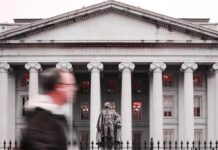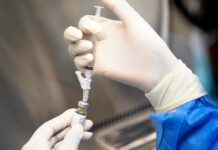In a Fox interview that aired Sunday, Trump dismissed concerns about the spike in infections by saying that “many of those cases shouldn’t even be cases” and that many are young people who just “have the sniffles.” He once again claimed that the virus “is going to disappear and I’ll be right.”
And his administration is taking a hard-line stance on the upcoming coronavirus relief bill, trying to block billions of dollars for states to conduct testing and contact tracing, my colleagues Erica Werner and Jeff Stein reported this weekend. “The administration is also trying to block billions of dollars that GOP senators want to allocate for the Centers for Disease Control and Prevention, and billions more for the Pentagon and State Department to address the pandemic at home and abroad.”
The Atlantic’s Derek Thompson on the split screen:
Biden holds a double-digit lead nationally in a new Washington Post-ABC News poll released yesterday.
“Trump’s prospects for winning in November appear to depend heavily on his ability to rally an enthusiastic core base of supporters and on convincing a broader swath of a largely skeptical public that he is dealing effectively with the pandemic,” my colleagues Dan Balz and Scott Clement report.
“Biden leads Trump 55 percent to 40 percent among registered voters. That compares with a 10-point Biden lead in May and a two-point edge in March, at a time when the pandemic was just beginning to spread rapidly in parts of the country,” they note.
Trump’s job approval rating has also deteriorated amid the pandemic and resulting economic fallout. “His job approval rating has dropped sharply in the past two months and stands at 39 percent positive and 57 percent negative among voting-age adults, with 48 percent of Americans saying they strongly disapprove of the way he is doing his job,” my colleagues write.” Note the difference from a late-March poll, “when just two points separated Biden and Trump in a head-to-head test, Trump’s approval rating stood at 48 percent positive and 46 percent negative.”
On Trump’s leadership on the coronavirus specifically, “there has been a net drop of 28 points in his approval margin since March as the president has repeatedly contradicted or ignored health experts in his administration and in the states, stoked confusion about the importance of wearing masks and at times appeared indifferent to the crisis even as conditions in many parts of the country were worsening. Currently, 38 percent approve of Trump’s handling of the pandemic, and 60 percent disapprove.”
Coronavirus infections are meanwhile rising in states across the country.
“More than a dozen states on Saturday [reached] record highs in their seven-day averages for new daily cases,” Derek Hawkins and Felicia Sonmez reported in the live blog. “Georgia, Missouri, Wisconsin, North Carolina and Kentucky reported new single-day case records on Saturday, while states from Vermont to North Dakota to Oregon showed significant increases in their weekly averages, according to tracking by The Washington Post.”
Death counts are also up: “More than 20 states are reporting seven-day averages in coronavirus-related deaths that are higher than at the end of June, underscoring the turnaround since May and June, when deaths declined nationally — which Trump had touted as a sign of progress.”
Hospitalizations are trending in the wrong direction, too: “Hospitals in hard-hit states such as Florida, Texas and Arizona are facing an influx of patients that health officials say could soon overwhelm medical systems. Nationwide, hospitalizations were on track to exceed their previous peak of roughly 60,000 reached in the pandemic’s early months.”
Trump in the Fox interview again falsely claimed the United States has the lowest coronavirus mortality rate in the world:
The Trump administration’s position on the relief bill has angered some Republicans.
Some lawmakers are seeking to ensure that the money stays in the bill despite the administration’s objections, per Erica and Jeff.
“One person involved in the talks said Senate Republicans were seeking to allocate $25 billion for states to conduct testing and contact tracing, but that certain administration officials want to zero out the testing and tracing money entirely. Some White House officials believe they have already approved billions of dollars in assistance for testing and that some of that money remains unspent.
“… The administration is also seeking to zero out $10 billion in new funding for the CDC in the upcoming bill, while slashing spending for the Pentagon and State Department related to foreign aid, the person said. Trump has been skeptical of State Department spending and foreign aid generally, but it was unclear why the Trump administration would seek to block money for the Pentagon for a variety of coronavirus-related expenses such as reimbursing contractors for providing paid leave to employees.”
Ahh, oof and ouch
AHH: A lack of federal leadership was just the beginning of the fiasco for the coronavirus response in the richest and most powerful nation.
“In the United States, coronavirus transmission is out of control. The national response is fragmented, shot through with political rancor and culture-war divisiveness,” they write. “Testing shortcomings that revealed themselves in March have become acute in July, with week-long waits for results leaving the country blind to real-time virus spread and rendering contact tracing nearly irrelevant… How the world’s richest country got into this dismal situation is a complicated tale that exposes the flaws and fissures in a nation long proud of its ability to meet cataclysmic challenges.”
The blunder has revealed a number of problems, from incoherent leadership and a dearth of investment in public health, and ongoing socioeconomic and racial inequities. The setbacks America has suffered overshadow any faced by other nations.
“The single biggest miscalculation was rushing to reopen the economy while the virus was still spreading at high rates through much of the country, experts say. The only way to reopen safely, epidemiologists said as far back as early April, was to ‘crush the curve’ — to drive down the rate of viral transmission to the point that new infections were few and far between,” Joel, William, Karin and Chelsea write.
Beth Cameron, who was senior director for global health security and biodefense on the White House National Security Council and helped write a pandemic response plan in the Obama administration, told The Post: “I just never expected that we would have such a lack of federal leadership, and it’s been deliberate… In a national emergency that is a pandemic, spreading between states, federal leadership is essential. And if there was any doubt about that, we ran that experiment from March and April until now. It failed. So we have to run a different experiment.”
OOF: Superspreading events are driving the pandemic, scientists warn.
These infection bursts are fueled by a single highly infectious individual who may be asymptomatic and unsuspectingly infecting many others. “They worry these cases, rather than routine transmission between one infected person and, say, two or three close contacts, are propelling case counts out of control,” Ariana Eunjung Cha reports.
She describes one such superspreading event that took place at a college bar in East Lansing in mid-June soon after the state began reopening. As of Friday, 187 people were found to be infected at Harper’s Restaurant and Brew Pub. The case is possibly the largest so far in the nation among the general public.
“More than 1,000 suspected clusters — ranging from the single digits to thousands — have been logged in a database compiled by a coder in the Netherlands. A megachurch in South Korea. A political rally in Madrid. An engagement party in Rio de Janeiro. Nearly all took place indoors, or in indoor-outdoor spaces,” Ariana writes. “Even as the Trump administration pressures schools to reopen this fall, the latest research suggests that understanding how and why these events occur — and how to prevent them — is key to reopening safely. In recent days, governors from at least 18 states, including Michigan, have backtracked on plans to loosen restrictions due to outbreaks.”
There are still a lot of questions about how the virus is transmitted, frustrating scientists who are trying to understand why some large gatherings seem to be spurring more cases than others.
“Part of the uneven spread of the coronavirus — and the phenomenon of superspreading — can be explained by extreme individual variation in infectivity, researchers say,” Ariana adds. “Some people will not transmit the virus to anyone, contact tracing has shown, while others appear to spread the virus with great efficiency. Overall, researchers have estimated in recent studies that some 10 to 20 percent of the infected may be responsible for 80 percent of all cases. Scientists are only starting to understand the different factors — physiological, behavioral, environmental — that play a role in amplifying transmission.”
OUCH: In Maine, black residents make up about 23 percent of cases in a state where they are less than 2 percent of the population.
The most updated state data finds at least 836 of more than 3,600 Maine residents who have been infected are black. A pattern has emerged pointing to the disproportionate impact on the state’s black population, many of them immigrants, Maria Sacchetti reports.
“Two of the state’s 115 coronavirus deaths have been among black Mainers, who health officials said tend to be younger and less likely to exhibit symptoms of the virus’s disease, covid-19,” she writes. “But advocates for immigrants say many have been ill, and a state lawmaker warned that black residents in Maine and nationwide are facing the ‘twin pandemics’ of systemic racism that hinders access to health care, and a virus that has disproportionately infected people of color.”
She adds: “Maine does not collect data for immigrants, following federal guidelines, but officials said contact tracing showed that many of those affected are immigrants or their children. Latinos account for a smaller number of cases, about 145 infections.”
Immigrant group leaders point fingers at an initial failure to offer bilingual contact tracers or provide adequate testing. State officials say they are now pushing to address the disparity with further testing and expanded health-care resources, as well as direct resources for immigrant groups and bilingual staff.
“It is deeply disheartening, and, frankly, unacceptable to me that Maine is confronting such significant racial disparities,” Gov. Janet Mills (D) said in a statement, adding the pandemic “has laid bare the deep-seated inequities and racism in our society that deserve our attention.”
The Trump administration’s efforts
Hospital groups are appealing the ruling that would force members to disclose negotiated rates.
The American Hospital Association filed an appeal of a ruling that upholds a Trump administration rule to mandate that hospitals make public the rates they negotiate with insurers. The trade groups argues in part that the requirement violates the First Amendment and is based on an unlawful interpretation of the Affordable Care Act, the Wall Street Journal’s Stephanie Armour reports.
The Trump rule “requires hospitals to publicize the rates they negotiate with individual insurers for all services, including drugs, supplies, facility fees and care by doctors who work for the facility,” Stephanie writes. “It is scheduled to take effect in January 2021, with hospitals facing fines of up to $300 a day if they don’t disclose negotiated rates.”
“HHS’s interpretation would implausibly produce thousands of different ‘standard charges’ for each of the thousands of items and services that hospitals offer—or millions of data points,” the appeal says.
A federal appeals court upheld a Trump administration rule expanding the availability of skimpy, inexpensive health plans.
The 2-to-1 ruling by a panel of the U.S. Court of Appeals for the District of Columbia Circuit was a win for the administration, which has sought to expand the short-term plans that don’t comply with the Affordable Care Act and that critics say don’t provide adequate coverage for consumers.
The appeals court found “even if such short-term insurance policies were bad for consumers, the departments of Health and Human Services, Treasury and Labor had the authority to let them be sold for longer periods of time,” Amy Goldstein reports. “…The ruling came the same week the administration and the state of Arkansas asked the Supreme Court to take two cases involving another cornerstone of the administration’s efforts to tilt health policy in a more conservative direction. For the first time in the half-century of Medicaid as safety-net insurance, HHS has allowed states to compel some people to work or prepare for a job in exchange for the health benefits.”
In a dissenting opinion, Judge Judith W. Rogers wrote that the short-term plans were meant to be a temporary solution. Amy adds: “Increasing the availability of such plans is part of Trump’s goal of repealing the ACA, Rogers says, adding that they “leave enrollees without benefits that Congress deemed essential” and tend to pull young, healthy customers out of ACA insurance marketplaces.”
The Food and Drug Administration has granted emergency use authorization for pooled covid-19 testing.
The testing strategy would combine testing samples from multiple people and test the samples as one batch. If the batch test result is positive, each sample would be tested individually to find out which people are infected, Politico’s Alice Miranda Ollstein reports.
In a statement, FDA Commissioner Stephen Hahn called it an “important step forward in getting more Covid-19 tests to more Americans more quickly while preserving testing supplies.”
“The FDA said that Quest Diagnostics will now be able to group up to four samples together. This is aimed at easing the current testing crunch driven by the spike in new infections,” Alice writes. “Pooled testing isn’t a silver bullet — for instance, it’s not appropriate for communities where outbreaks are widespread, FDA Commissioner Stephen Hahn said in a statement. But in areas where the prevalence of the virus is low, pooled testing can reduce consumption of scarce testing resources on people who are not likely to be infected but need to be screened before they can return to work or school.”
Coronavirus latest
Here are a few more stories to catch up on after the weekend:
Congress on coronavirus:
- Endangered Senate Republicans are facing pressure as they try to determine what to include in the next coronavirus relief package. They are dealing with competing demands “from President Trump and Republican senators, including some who are up for reelection in states hit hard by the virus and are coming under withering attacks by Democratic challengers over the pandemic,” Seung Min Kim, Rachael Bade and Erica Werner report.
More on administration efforts:
- The Trump administration is donating thousands of ventilators to other nations. But many are going to countries that don’t need them as much as they need other critical resources, and it’s not clear how the receiving countries are chosen, ProPublica’s Yeganeh Torbati reports.
- During his “Fox News Sunday” interview, Trump called Anthony S. Fauci, the nation’s top infectious-disease expert, a “little bit of an alarmist” but said he has a “very good relationship” with him.
- Former FDA chief Scott Gottlieb writes in the Wall Street Journal that an interagency feud between HHS and CDC over key data demonstrates the inadequacy of U.S. efforts to prepare for a pandemic.
The spread of misinformation:
- A research coordinator at the University of Pennsylvania’s School of Medicine has spent months diving deep into Facebook groups to try to combat coronavirus misinformation, Hannah Knowles reports. “My biggest thing is, there is this outright rejection of science and what our best scientific knowledge is able to impart,” Phil Cochetti told The Post.
In the region:
- The greater Washington area is one of many places across the country with growing delays in testing turnaround times. “Private labs have been hamstrung by supply line shortages and overwhelming demand. Some labs have prioritized hospital patients or contracts with big employers, including the NBA, placing the general public at the back of a line that can grow longer by the day,” Erin Cox reports.
- Meanwhile, D.C., Maryland and Virginia reported 2,049 new coronavirus cases yesterday, Rebecca Tan reports. It was the highest single-day increase since late May.








